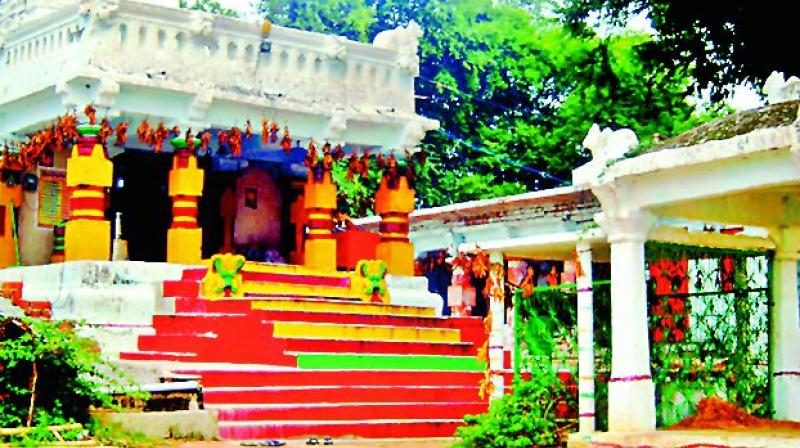A pretty Shiva temple by the Meenambaram river

Hyderabad: The Sparshvedishwara Swamy temple is on the banks of the Meenambaram, a tributary of the Krishna.
The village is named after the tributary and it is not far from Jadcherla. Meenambaram gets its water from the overflow of the Lokerevu lake, traverses a check dam and connects with the Dundubi river which ends at the Dindi dam.
“We get regular water flow in the Meenambaram because of the Uddandapur reservoir. Now there is continuous water flow because of the various projects,” says temple chairman Bodda Gopal.
The water has sometimes inundated the temple. The ambience is picture perfect. Once you cross the Krishna over the beautiful Alwanpally bridge, the Meenambaram village is just a few furlongs away. Unfortunately the Alwanpally bridge, close to 100 years old and with a check dam below it, is to be destroyed because it has become weak and cannot take the traffic.
This memory of past engineering should be kept alive and a parallel bridge can be built, but the final decision lies with the powers that be.
Once you turn into the village road, it turns picturesque with cotton fields on either side and speeding tractors apparently bringing sand to the temple.
The picture is not complete without the herd of goats running helter-skelter while the goatherd simply stands there, eyes half closed.
The entrance to the temple faces the river and colourful benches along with a small and colourful ratham made of metal welcome you. It is a small temple but built on such an idyllic site that it is surprising that there are no droves of tourists visiting this place. But then, unfortunately, a combination of a lackadaisical archaeology department and the tourism department robs the people of an opportunity of visiting such beautiful spots.
Mr Gopal is supervising some construction work. “We are just adding a slab on top as protection because when crowds come children tend to climb up and then fall off because of lack of support,” he says reassuring that he is not changing the face of this 9th century temple.
Being a Lord Shiva temple, Shivaratri is celebrated with great pomp. “But we also have pujas every Monday,” Mr Gopal said. On special occasions a priest is called to perform the puja.
The temple is now under the endowments department and is a protected monument under the archaeology department.
Meenambaram village comes under Korragadapalli gram panchayat, though earlier it was under Nekonda.
“The unique thing about the temple is that it is west-facing. This was done probably because of the river,” explained Mr Gopal.
Since you can touch the Shiva Linga and worship it, it is called Sparshavedishwara.
The temple itself has two acres of land and is surrounded by tamarind and neem trees and the breeze is soothing and calm.
“We have taken two acres of land on the river bed and growing 50 varieties of herbs, Mr Gopal said. It will probably get flooded if there is excess water in the lake and if there is more rain.”
Meenambaram, apart from being the name of the river and village, means fish caught in the net but which bounced back into the river.
There is a small chatram with a beautifully maintained garden. Hidden in the bushes is a Lord Mahavir statue with no head and this is the link that maybe this was a Jaina temple earlier. There is just a kilometre away the ruin of an old Jaina temple called the Gollatha Gullu.
The Shiva Linga is large and is on a huge ‘Panamatam’, all made of black granite.
The entire temple is covered with Nandis. Just outside of the temple on the left is a small neat little samadhi, apparently constructed for the builder. There are Naga statues also.
Legend has it that this used to be a Jain temple, estimated to be constructed around the eighth century AD and later converted into a Lord Shiva temple.
The headless statue of Lord Mahavira and an inscription which states that Sage Agastya converted this Jaina temple into a Lord Shiva temple is proof enough.
The temple was built during the last days of Krishna Rashtrakuta III, who ruled between 939 and 967 AD.

